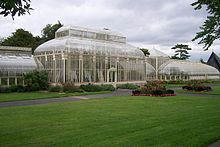- National Botanic Gardens (Ireland)
-
National Botanic Gardens Garraithe Náisiúnta na Lus 
Type Botanic Garden Location Glasnevin, Dublin Coordinates 53°22′19.20″N 6°16′22.80″W / 53.372°N 6.273°W Area 19.5 ha (48 acres) Created 1795 Operated by Office of Public Works Status Open all year Website www.botanicgardens.ie The National Botanic Gardens (Irish: Garraithe Náisiúnta na Luais) are located in Glasnevin, 5 km north-west of Dublin city centre, Ireland[1]. The 19.5 hectares[2] are situated between Prospect Cemetery and the River Tolka where it forms part of that river's floodplain.
The gardens were founded in 1795 by the Dublin Society (later the Royal Dublin Society) and they have grown to hold 20,000 living plants and many millions of dried plant specimens. There are several architecturally notable greenhouses. Today the Glasnevin site is the headquarters of the National Botanic Gardens of Ireland which has a satellite garden at Kilmcurragh in county Wicklow.
The botanic garden participates in national and international initiatives for biodiversity conservation and sustainable development. The Director, Dr. Matthew Jebb, is also Chairman of PlantNetwork: The Plant Collections Network of Britain and Ireland.
Contents
History
The poet Thomas Tickell owned a house and small estate in Glasnevin and, in 1790, they were sold to the Irish Parliament and given to the Royal Dublin Society for them to establish Ireland's first botanic gardens. A double line of yew trees, known as "Addison's Walk" survives from this period.[3] The original purpose of the gardens had been to advance knowledge of plants for agriculture, medicine and dyeing. The gardens were the first location in Ireland where the infection responsible for the 1845–1847 potato famine was identified. Throughout the famine, research to stop the infection was undertaken at the gardens.
Walter Wade and John Underwood, the first Director and Superintendent respectively, executed the layout of the gardens, but, when Wade died in 1825, they declined for some years. From 1834, Director Ninian Nivan brought new life into the gardens, performing some redesign. This programme of change and development continued with the following Directors into the late 1960s.[3]
The gardens were placed into government care in 1879.
Facilities
As well as being a tourist destination and an amenity for nearby residents, it also serves as a centre for horticultural research and training, including the breeding of many prized orchids.
The soil at Glasnevin is strongly alkaline (in horticultural terms) and this restricts the cultivation of calcifuge plants such as rhododendrons to specially prepared areas. Nonetheless, the gardens display a range of outdoor "habitats" such as a rockery, herbaceous border, rose garden, bog garden and arboretum. A vegetable garden has also been established.
The National Herbarium is also housed at the National Botanic Gardens. It contains a collection of nearly 750,000 pressed plants, collected over the garden's two-hundred-year history. The gardens contain noted and historically important collections of orchids. The newly restored Palm House houses many tropical and subtropical plants. The Cactus House is currently (2008) being emptied for refurbishment.
In 2002, a new multistorey complex was built; it includes a cafe and a large lecture theatre.
It has responsibility for the Arboretum at Kilmacurragh, County Wicklow, a centre noted for its conifers and calcifuges. This is located some 50 kilometres (30 mi) south of Dublin.
Architecture
The gardens include some glasshouses of architectural importance, such as the Palm House and the Curvilinear Range.
The Curvilinear Range was completed in 1848 by Richard Turner, an Irish iron-founder and pioneer in the constructional use of wrought iron; it was extended in the late 1860s. This structure, and the nearby Palm House (built 1884), have been restored (using some surplus contemporary structural ironwork from Kew Gardens) and this work attracted the Europa Nostra award for excellence in conservation architecture.[1]
Directors
The Director is the chief officer of the Gardens, with a residence provided on site. Previous Directors include[3]:
- Dr Walter Wade, Professor of Botany to the Dublin Society (until 1825)
- Samuel Litton (1825–1834)
- Ninian Nivan (1834–1838)
- Dr David Moore (1838–79)
- Sir Frederick Moore (1879–1922)
- J. W. Besant (1922–44)
- Dr T. J. Walsh (1944–68)
- Aidan Brady (1968–1993)
- Donal M. Synnott (1994–2004)
- Dr Peter Wyse Jackson (2005–2010)
- Dr Matthew Jebb (2010- )
See also
- List of Irish botanical illustrators
- List of Irish plant collectors
- The Ferns of Great Britain and Ireland
References
- ^ a b "Heritage Ireland: National Botanic Gardens". Office of Public Works. http://www.heritageireland.ie/en/Dublin/NationalBotanicGardens/. Retrieved 2011-11-02.
- ^ "Ireland.com National Botanic Gardens". http://www.ireland.com/tours-and-attractions/attractions/national-botanic-gardens/181131. Retrieved 2011-11-02.
- ^ a b c "National Botanic Gardens, Glasnevin". Irelandseye.com. 1999-2005. http://www.irelandseye.com/aarticles/travel/attractions/gardens/glasnevn.shtm. Retrieved 2008-09-14.
External links
Dublin Parks Botanic Gardens · Bull Island · Bushy Park · Corkagh Park · Fairview Park · Fitzwilliam Square · Fr. Collins Park · Garden of Remembrance · Herbert Park · Irish National War Memorial Gardens · Iveagh Gardens · Marlay Park · Merrion Square · Mountjoy Square · People's Park · Phoenix Park · St Anne's Park · St. Enda's Park · St Stephen's GreenCategories:- Botanical gardens in the Republic of Ireland
- Glasnevin
- Science and technology in the Republic of Ireland
- Visitor attractions in Dublin (city)
Wikimedia Foundation. 2010.




